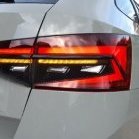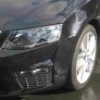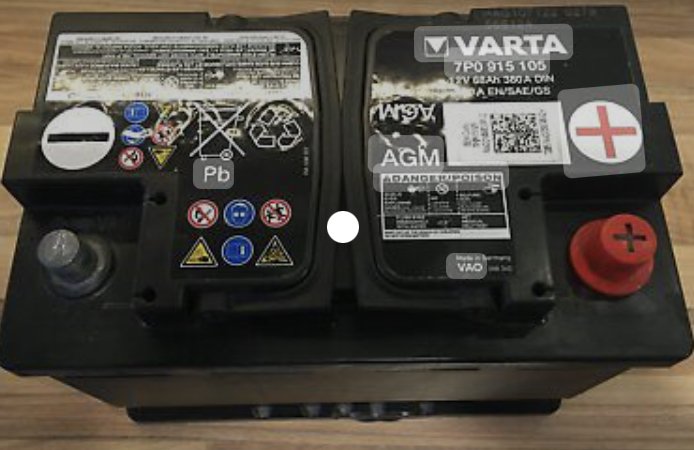-
Posts
387 -
Joined
-
Last visited
Profile Information
-
Gender
Male
-
Location
Hobbiton by 'The Shire' Country Park.
Car Info
-
Model
Fabia III MC DSG, Octavia III vRS 4x4
-
Year
2016
Recent Profile Visitors
2,404 profile views
BigEjit's Achievements
-
Micro hybrid is its correct term. It’s a software controlled way of reducing energy consumption and emissions by putting more work through the battery and only using alternator output when needed. It’s constantly varying and needs to know what is going on throughout the electrical circuits to determine the correct alternator output. It’s also set up to maximise the life expectancy of the battery during an average lifetime duty cycle. Unregulated charging overcharges the battery, excess energy is turned to heat. The last thing you need in a 12v battery is excess heat as it accelerates decay. A standard battery will work in S/S applications but it’s set up means it’s approx 50% less durable than the equivalent AGM. AGM - Absorbent Glass Mat Top spec SS battery that takes a lot of abuse very well and accepts charge faster than the alternatives. EFB - Enhanced Flooded Battery Entry level S/S battery with polymer based plate envelopes and electrolyte mixer elements to boost durability against abuse. A halfway house between SLI and AGM. SLI Flooded battery Starting/Lights/Ignition A basic battery that does the job but has no thrills at the expense of long term performance and resistance to abuse. Has a deep cycle frequency of around 50% less than the equivalent AGM. Will overheat quicker than alternatives if overcharged leading to moisture loss, wear, premature failure. Most likely to short circuit a cell or fail early out of these three battery types.
-
BigEjit started following Battery not charging warnings , Battery replacement , Battery keeps going flat and 6 others
-
If StopStart function is on your vehicle, you need an EFB or AGM 096 battery (marked as such on the lid). A standard SLI flooded isn’t up to the job of handling S/S charging profiles over time and wears out quicker than the S/S graded batteries even if S/S function is switched off. S/S function is more than just cutting the engine when stationary.
-
Sounds like an intermittent short circuit cell in the battery. This can happen if the battery has had a long period of discharge in the past promoting sulphate crystal growth that cannot be reversed. Add in an element of cupping of the plates from aging or frequent deep cycling and related heat and the short circuit can show when the battery warms up as the cupping effect increases. If you are able to check the battery voltage during a period of non start and it is around 10,5v, this will be your issue, confirmed further if it suddenly recovers to normal 12.5ish volts. (Intermittent short circuit.) Replacement of the battery is the only solution to these symptoms.
-

So, What Would YOU Do, With This Heap?
BigEjit replied to Throw_Rope's topic in Skoda Fabia Mk III (2014-2021)
Low mileage vehicle = primary reason for the battery discharging and becoming ruined. Stop Start not working frequently = an indicator of a ruined battery Power consumption high = electrical system compensating for ruined battery Random electrical notifications = linked to ruined batteries I guess your battery is ruined. EFB is a stop/start battery but an AGM would be better for your driving duty cycle as it will take more discharge/recharge abuse. If the car isn't used much, this will also need replacing in the future as its not an infinite power source and needs a frequent long feed of electrical energy to keep it charged and alive. -

Battery issues and Auto Stop/Start not working
BigEjit replied to RIncewindwiz's topic in Skoda Octavia Mk III (2013 - 2020)
Exactly this^^^^ Batteries are dumb organic lumps that need to be maintained as close to 12.72v (12.8v AGM) open circuit voltage as possible and used regularly to avoid performance decay. The only key factor is that AGM batteries need to be charged with a limited voltage of 15v. Too much current, overcharging or rapid charging of any 12v lead acid battery will cause moisture loss through 'splitting' of the water content into oxygen and hydrogen gas. Do this too much and the moisture content loss will lead to a spark between dry spots on the plates igniting the gas in the space above. This does happen on batteries that are repeatedly deep discharged and recharged fairly quickly and frequently. AGM retain all the moisture in the glass mats, EFB and standard SLI batteries are wet flooded with far more electrolyte content. If a battery is discharged towards 12v, sulphates start forming straight away. (Cant be helped, its what happens) They are reabsorbed when the battery is recharged. If they are left to harden by not fully recharging within a week or so or the battery is deep discharged, the sulphate crystals rob a little capacity from the battery by taking up/destroying some of the active material in the plates and won't dissolve back into the electrolyte. Keeping the battery in a low state of charge reinforces this until the crystals grow into the adjacent plate and create a permanent short circuit cell killing the battery or the storage capacity has been destroyed so much the battery can't hold enough energy to spin the starter and supply the vehicle systems at the same time. Low mileage vehicles (7k kms/year is low!) typically kill off batteries in this way. Short trips won't fully charge a battery and the Cold Cranking Amps (CCA)/storage capacity just gets progressively lower and lower. Even the odd longer trip won't be enough to help the battery recover. Voltage can be fine initially but drops off really quickly with any reasonable current draw applied. As a guide from 12.0v, chargers need to be left in place for 24 hours to reach 12.72v or higher and achieve full saturation of the plates. AGM's will reach and hold 13v fully charged. When recharging, the battery is fine if it is still cool to the touch or its not venting sulphurous gas which you can smell. In the factories as a comparison, they rapid charge them several times whilst sitting in cooling baths and the air has a lingering eggy smell. Smart chargers are set to control the charge rates for home use appropriate to the battery performance and type. -

Battery issues and Auto Stop/Start not working
BigEjit replied to RIncewindwiz's topic in Skoda Octavia Mk III (2013 - 2020)
1, Lockdown killed off plenty of batteries due to inactive vehicles. After approx 6 weeks layup with the battery connected, they will be in a discharged state with sulphates growing and hardening = unrecoverable capacity losses result ultimately requiring an early life change of battery if not fully charged ASAP! 2, Low battery warnings frequently coincide with other abnormal electrical warnings. 3, The principle signature of a discharged damaged battery is failing stop start esp if all other consumers are off. Do you know if the new battery was stored fully charged before you bought it or its age? Did you use the vehicle frequently after fitting the battery before having to externally charge? If no to either of these, this is the most likely root cause. 4, What sort of usage pattern do you have with the vehicle? Approx annual Kms/miles and downtime between journeys as an average? This is another key indicator of response and performance from the battery you are reporting and also a common root cause of early life failures. 5, Current draw is more important than voltage loss when vehicle is fully asleep - should be around 0.014Amps if i remember right. Any more and the battery discharges sooner requiring more use or charge cycles to compensate or even more unlikely, indicates a consumer is failing to switch off correctly (Dashcams are prime favourite here) 6, A fully discharged battery needs 24hrs to recharge and saturate the plates. a few hours run time won't have much lasting affect and leave the battery back in the original discharged state very quickly if the usage pattern stays the same. Frequent full recharging from fully discharged by just running the vehicle on periodic long journeys can also increase wear rates on the battery and lead to moisture loss and overheating. Heat from frequent and brutal alternator based recharging from fully discharged state and/or intense summer temps also damages the battery from moisture loss and by turning the plates to mush losing capacity, which then usually shows in winter when cold. Overcharging a battery results in surplus energy being turned to heat..., which boosts waterloss..., which pushes things closer towards self detonation if there is a significant presence of internal damage already....... -
Standard anthracite 19”. I have never had an issue with them but I do go around anything that looks like a pothole so they don’t get wrecked. The ride quality is fine. Just marginally more input from finer road surface harshness over a softer tyred 18” but no where near bad or off putting. Avoid kerbs and placing face down if taken off the car as the front face stands proud of a 225 tyre.
-
Thanks for the positivity. Much appreciated! There’s quite a lot of open source info out on the internet, much more than I could ever fill a guide with. What isn’t so easily available is the answer to somebody’s immediate issue, especially as batteries are fickle organic lumps in a digital world and react to unique situations in different ways. I try to help others out by explaining why a battery is doing what it’s doing based on its history. I guess we all want to help others experiencing issues anyway which is why we are all here. BTW, the only real rule for chargers is ensure a voltage limited device to 14.8v is used on an AGM. If it has AGM program, sorted!! EFB and Flooded are less fussy than AGM charging wise but need more attention and care as they are needy that way.
-
***Long geeky post alert*** Going off the battery label part number in you pic, you have one of these AGMs currently as in the pic below and it looks like the original battery. Check the date on the +ve terminal and it should show Mm/yy format (expecting a 12 for the year if original fit). 7P0 915 105 VARTA AGM Stop start is currently not working as the battery has fatigued and the car has recognised this. (There is a lot more hidden functionality to the Stop Start set up other than just cutting and restarting the engine.) For Stop Start functions, ideally you should swap like for like AGM tech battery. For your usage pattern, the 2 reasons for this are…. 1, AGM is the best tech for Stop Start functionality as it is handles the tougher duty cycle the vehicle is set up to operate under. Fitting a lesser tech battery such as EFB or standard flooded won’t have much of a performance impact short term and stop start functionality will be restored but they will be under more operational stress and wear out quicker with vehicle use. 2, As you are barely using the vehicle, the battery if left connected with monthly external charging cycles will be in a constant pattern of discharge/ recharge. AGM is the best battery tech to handle this type of duty cycle as it is more resistant to sulphation damage during discharge phases and recovers best on a recharge. Lesser tech won’t recover from discharge damage as well as AGM adding to a faster demise than what you have experienced so far. A third reason to stick with AGM is that by regular discharge/ recharge cycling, batteries are more at risk of drying out. AGM are valve regulated to prevent this, EFB and flooded are more vented and lose moisture quicker putting them at greater risk of ‘popping’ after a few years of the same regime. For a battery of 10 years aged and only now showing fatigue is exceptional for the duty cycle it’s operating under and is a testament to AGM performance. It’s been well maintained but is now wearing out. You won’t get the same longevity from lesser tech batteries if you are planning on keeping the car for a good few years yet.
-
Volts seem a little low, would expect to see approx 12.4v, ignition off, key out, car unlocked. Have you got a Midtronics reading of battery performance in particular Volts, CCA and temp vs label rating? At 12.72v open circuit at 15'C, you should have a CCA reading approx 10 to 15% higher than the label rating if the battery is decent, matching or less than the label rating and its suffering. A small loss of battery capacity across the cell packs will still give adequate voltage range but drop the vehicle response into S/S inhibit. The EFB on our Fab wouldn't flag the faults you have shown but certainly prevented S/S operating unless externally recharged, then performance dropped off again a few days later and stayed there. Swapped it out for an AGM for the duty cycle the vehicle is used in and not had a problem since.
-
This whole thread is a list of symptoms. The root cause is likely a partial loss of capacity in the battery due to a long period of inactivity such as the vehicle being parked up during lockdown and being recharged instead of replaced. A connected battery left in place for months will discharge into a state of irreversible internal damage. See if you can find the build date of the vehicle somewhere and compare it to the sale date. Varta batteries will have a date code on a terminal in Mm/Yy format and will predate the vehicle by a few weeks. If you find a lay up period of a few months, there’s the root cause - new battery time if the dealer didn’t use a battery care process, didn’t recharge once per month if still connected, or didn’t disconnect the battery for long time storage.
-

Battery not charging warnings
BigEjit replied to Irishgirl's topic in Skoda Octavia Mk III (2013 - 2020)
It takes a lot of work to put a battery into a condition to crack a case. Stop start operational voltage range is OK for a standard flooded SLI to handle, it’s the aggressiveness of discharge/ recharge current and frequency that does the long term damage. Ok to use SLI short term for a few weeks, still needs the right spec battery long term. -

Battery not charging warnings
BigEjit replied to Irishgirl's topic in Skoda Octavia Mk III (2013 - 2020)
If the alternator is goosed, you will have the same issues turn up. It’s rare for alternator defects to appear though. Batteries are more sensitive to passive abuse and more likely to give issues as a result. Inhibiting the stop start function on the button will save the standard battery from having to crank the engine frequently taking some of the stress off it. It will still be open to the work load of the charging strategy that’s operating in the back ground that you can’t change without external equipment. A frequently active stop start function is also a good indicator of a good battery. Stop start will still need an EFB or better performing AGM to handle the duty cycle. Battery performance is difficult to measure accurately. Even the best gadgets at dealerships need an experienced head to interpret the results based on other variables around battery life. Without having the measured values for Voltage, CCA and ambient temp to hand, it’s a bit of guess work to determine root cause. However… Common causes of battery failure are:- Infrequent short trips Below average mileage vs age A significant period of discharge during the life of the battery such as being laid up for a couple of months at holding yards or dealership forecourt’s with the battery connected allowing it to fully discharge. This could occur at any time from the moment the battery was first fitted to present day. Deep diving the vehicle history may find a period of time suitable to fit this pattern. Repeat exposure to high heat soaking increasing internal decay which shows up later in cold environments as poor performance. High mileage/ taxi duty cycle wearing it out. Old age heading towards 10+ years service. 6 months lockdown with zero use/ needed a jump start. I hope that sheds some light on things for you. -

Battery not charging warnings
BigEjit replied to Irishgirl's topic in Skoda Octavia Mk III (2013 - 2020)
If you have swapped the EFB battery out and the issue has gone away, that’s an indication the old EFB battery is not performing right. Stop Start not working that often is another indicator of an end of life battery. If you put the EFB back in and the issue returns, it’s definitely the cause and best practice would be to replace it with the same spec, higher rated EFB or pick an AGM of same case size. You can get a charger for it to see if it will recover a little but if it’s not OK in a frequently used car, recharging won’t help so just swap it out anyway. Short term, the standard flooded battery will be ok to use as a substitute but the cars charging set up for EFB will work it harder than the battery spec is designed for. You won’t notice much difference, it just wears out quicker requiring replacement sooner.


.thumb.jpg.f0e86d2be27be6fdcb438e103680c4c0.jpg)






